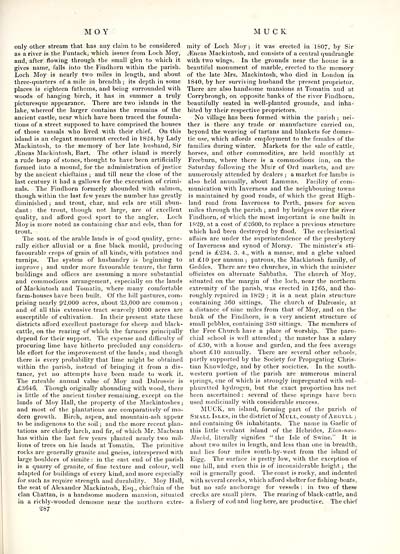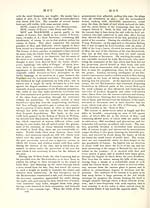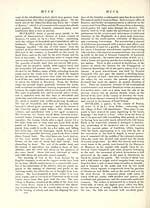Topographical dictionary of Scotland > Volume 2
(295) Page 287
Download files
Complete book:
Individual page:
Thumbnail gallery: Grid view | List view

MO Y
MUCK
only other stream that has any claim to be considered
as a river is the Funtack, which issues from Loch Moy,
and, after flowing through the small glen to which it
gives name, falls into the Findhorn within the parish.
Loch Moy is nearly two miles in length, and about
three-quarters of a mile in breadth ; its depth in some
places is eighteen fathoms, and being surrounded with
woods of hanging birch, it has in summer a truly
picturesque appearance. There are two islands in the
lake, whereof the larger contains the remains of the
ancient castle, near which have been traced the founda-
tions of a street supposed to have comprised the houses
of those vassals who lived with their chief. On this
island is an elegant monument erected in 1S24, by Lady
Mackintosh, to the memory of her late husband, Sir
jEneas Mackintosh, Bart. The other island is merely
a rude heap of stones, thought to have been artificially
formed into a mound, for the administration of justice
by the ancient chieftains ; and till near the close of the
last century it had a gallows for the execution of crimi-
nals. The Findhorn formerly abounded with salmon,
though within the last few years the number has greatly
diminished ; and trout, char, and eels are still abun-
dant : the trout, though not large, are of excellent
quality, and afford good sport to the angler. Loch
Moy is more noted as containing char and eels, than for
trout.
The soil of the arable lands is of good quality, gene-
rally either alluvial or a fine black mould, producing
favourable crops of grain of all kinds, with potatoes and
turnips. The system of husbandry is beginning to
improve ; and under more favourable tenure, the farm
buildings and offices are assuming a more substantial
and commodious arrangement, especially on the lands
of Mackintosh and Totnatin, where many comfortable
farm-houses have been built. Of the hill pastures, com-
prising nearly 92,000 acres, about 23,000 are common ;
and of all this extensive tract scarcely 1000 acres are
susceptible of cultivation. In their present state these
districts afford excellent pasturage for sheep and black-
cattle, on the rearing of which the farmers principally
depend for their support. The expense and difficulty of
procuring lime have hitherto precluded any considera-
ble effort for the improvement of the lands; and though
there is every probability that lime might be obtained
within the parish, instead of bringing it from a dis-
tance, yet no attempts have been made to work it.
The rateable annual value of Moy and Dalrossie is
£3646. Though originally abounding with wood, there
is little of the ancient timber remaining, except on the
lands of Moy Hall, the property of the Mackintoshes ;
and most of the plantations are comparatively of mo-
dern growth. Birch, aspen, and mountain-ash appear
to be indigenous to the soil ; and the more recent plan-
tations are chiefly larch, and fir, of which Mr. Macbean
has within the last few years planted nearly two mil-
lions of trees on his lands at Tomatin. The primitive
rocks are generally granite and gneiss, interspersed with
large boulders of sienite : in the east end of the parish
is a quarry of granite, of fine texture and colour, well
adapted for buildings of every kind, and more especially
for such as require strength and durability. Moy Hall,
the seat of Alexander Mackintosh, Esq., chieftain of the
clan Chattan, is a handsome modern mansion, situated
in a richly-wooded demesne near the northern extre-
287
mity of Loch Moy; it was erected in 1807, by Sir
/Eneas Mackintosh, and consists of a central quadrangle
with two wings. In the grounds near the house is a
beautiful monument of marble, erected to the memory
of the late Mrs. Mackintosh, who died in London in
1840, by her surviving husband the present proprietor.
There are also handsome mansions at Tomatin and at
Corrybrough, on opposite banks of the river Findhorn,
beautifully seated in well-planted grounds, and inha-
bited by their respective proprietors.
No village has been formed within the parish ; nei-
ther is there any trade or manufacture carried on,
beyond the weaving of tartans and blankets for domes-
tic use, which affords employment to the females of the
families during winter. Markets for the sale of cattle,
horses, and other commodities, are held monthly at
Freeburn, where there is a commodious inn, on the
Saturday following the Muir of Ord markets, and are
numerously attended by dealers ; a market for lambs is
also held annually, about Lammas. Facility of com-
munication with Inverness and the neighbouring towns
is maintained by good roads, of which the great High-
land road from Inverness to Perth, passes for seven
miles through the parish ; and by bridges over the river
Findhorn, of which the most important is one built in
1829, at a cost of £2600, to replace a previous structure
which had been destroyed by flood. The ecclesiastical
affairs are under the superintendence of the presbytery
of Inverness and synod of Moray. The minister's sti-
pend is £234. 3. 4., with a manse, and a glebe valued
at £10 per annum ; patrons, the Mackintosh family, of
Geddes. There are two churches, in which the minister
officiates on alternate Sabbaths. The church of Moy,
situated on the margin of the loch, near the northern
extremity of the parish, was erected in 1765, and tho-
roughly repaired in 1829; it is a neat plain structure
containing 360 sittings. The church of Dalrossie, at
a distance of nine miles from that of Moy, and on the
bank of the Findhorn, is a very ancient structure of
small pebbles, containing 380 sittings. The members of
the Free Church have a place of worship. The paro-
chial school is well attended ; the master has a salary
of £30, with a house and garden, and the fees average
about £10 annually. There are several other schools,
partly supported by the Society for Propagating Chris-
tian Knowledge, and by other societies. In the south-
western portion of the parish are numerous mineral
springs, one of which is strongly impregnated with sul-
phuretted hydrogen, but the exact proportion has not
been ascertained : several of these springs have been
used medicinally with considerable success.
MUCK, an island, forming part of the parish of
Small Isles, in the district of Mull, county of Argyll ;
and containing 68 inhabitants. The name in Gaelic of
this little verdant island of the Hebrides, Elan-nan-
Muchd, literally signifies " the Isle of Swine." It is
about two miles in length, and less than one in breadth,
and lies four miles south-by- west from the island of
Eigg. The surface is pretty low, with the exception of
one hill, and even this is of inconsiderable height ; the
soil is generally good. The coast is rocky, and indented
with several creeks, which afford shelter for fishing-boats,
but no safe anchorage for vessels : in two of these
creeks are small piers. The rearing of black-cattle, and
a fishery of cod and ling here, are productive. The chief
MUCK
only other stream that has any claim to be considered
as a river is the Funtack, which issues from Loch Moy,
and, after flowing through the small glen to which it
gives name, falls into the Findhorn within the parish.
Loch Moy is nearly two miles in length, and about
three-quarters of a mile in breadth ; its depth in some
places is eighteen fathoms, and being surrounded with
woods of hanging birch, it has in summer a truly
picturesque appearance. There are two islands in the
lake, whereof the larger contains the remains of the
ancient castle, near which have been traced the founda-
tions of a street supposed to have comprised the houses
of those vassals who lived with their chief. On this
island is an elegant monument erected in 1S24, by Lady
Mackintosh, to the memory of her late husband, Sir
jEneas Mackintosh, Bart. The other island is merely
a rude heap of stones, thought to have been artificially
formed into a mound, for the administration of justice
by the ancient chieftains ; and till near the close of the
last century it had a gallows for the execution of crimi-
nals. The Findhorn formerly abounded with salmon,
though within the last few years the number has greatly
diminished ; and trout, char, and eels are still abun-
dant : the trout, though not large, are of excellent
quality, and afford good sport to the angler. Loch
Moy is more noted as containing char and eels, than for
trout.
The soil of the arable lands is of good quality, gene-
rally either alluvial or a fine black mould, producing
favourable crops of grain of all kinds, with potatoes and
turnips. The system of husbandry is beginning to
improve ; and under more favourable tenure, the farm
buildings and offices are assuming a more substantial
and commodious arrangement, especially on the lands
of Mackintosh and Totnatin, where many comfortable
farm-houses have been built. Of the hill pastures, com-
prising nearly 92,000 acres, about 23,000 are common ;
and of all this extensive tract scarcely 1000 acres are
susceptible of cultivation. In their present state these
districts afford excellent pasturage for sheep and black-
cattle, on the rearing of which the farmers principally
depend for their support. The expense and difficulty of
procuring lime have hitherto precluded any considera-
ble effort for the improvement of the lands; and though
there is every probability that lime might be obtained
within the parish, instead of bringing it from a dis-
tance, yet no attempts have been made to work it.
The rateable annual value of Moy and Dalrossie is
£3646. Though originally abounding with wood, there
is little of the ancient timber remaining, except on the
lands of Moy Hall, the property of the Mackintoshes ;
and most of the plantations are comparatively of mo-
dern growth. Birch, aspen, and mountain-ash appear
to be indigenous to the soil ; and the more recent plan-
tations are chiefly larch, and fir, of which Mr. Macbean
has within the last few years planted nearly two mil-
lions of trees on his lands at Tomatin. The primitive
rocks are generally granite and gneiss, interspersed with
large boulders of sienite : in the east end of the parish
is a quarry of granite, of fine texture and colour, well
adapted for buildings of every kind, and more especially
for such as require strength and durability. Moy Hall,
the seat of Alexander Mackintosh, Esq., chieftain of the
clan Chattan, is a handsome modern mansion, situated
in a richly-wooded demesne near the northern extre-
287
mity of Loch Moy; it was erected in 1807, by Sir
/Eneas Mackintosh, and consists of a central quadrangle
with two wings. In the grounds near the house is a
beautiful monument of marble, erected to the memory
of the late Mrs. Mackintosh, who died in London in
1840, by her surviving husband the present proprietor.
There are also handsome mansions at Tomatin and at
Corrybrough, on opposite banks of the river Findhorn,
beautifully seated in well-planted grounds, and inha-
bited by their respective proprietors.
No village has been formed within the parish ; nei-
ther is there any trade or manufacture carried on,
beyond the weaving of tartans and blankets for domes-
tic use, which affords employment to the females of the
families during winter. Markets for the sale of cattle,
horses, and other commodities, are held monthly at
Freeburn, where there is a commodious inn, on the
Saturday following the Muir of Ord markets, and are
numerously attended by dealers ; a market for lambs is
also held annually, about Lammas. Facility of com-
munication with Inverness and the neighbouring towns
is maintained by good roads, of which the great High-
land road from Inverness to Perth, passes for seven
miles through the parish ; and by bridges over the river
Findhorn, of which the most important is one built in
1829, at a cost of £2600, to replace a previous structure
which had been destroyed by flood. The ecclesiastical
affairs are under the superintendence of the presbytery
of Inverness and synod of Moray. The minister's sti-
pend is £234. 3. 4., with a manse, and a glebe valued
at £10 per annum ; patrons, the Mackintosh family, of
Geddes. There are two churches, in which the minister
officiates on alternate Sabbaths. The church of Moy,
situated on the margin of the loch, near the northern
extremity of the parish, was erected in 1765, and tho-
roughly repaired in 1829; it is a neat plain structure
containing 360 sittings. The church of Dalrossie, at
a distance of nine miles from that of Moy, and on the
bank of the Findhorn, is a very ancient structure of
small pebbles, containing 380 sittings. The members of
the Free Church have a place of worship. The paro-
chial school is well attended ; the master has a salary
of £30, with a house and garden, and the fees average
about £10 annually. There are several other schools,
partly supported by the Society for Propagating Chris-
tian Knowledge, and by other societies. In the south-
western portion of the parish are numerous mineral
springs, one of which is strongly impregnated with sul-
phuretted hydrogen, but the exact proportion has not
been ascertained : several of these springs have been
used medicinally with considerable success.
MUCK, an island, forming part of the parish of
Small Isles, in the district of Mull, county of Argyll ;
and containing 68 inhabitants. The name in Gaelic of
this little verdant island of the Hebrides, Elan-nan-
Muchd, literally signifies " the Isle of Swine." It is
about two miles in length, and less than one in breadth,
and lies four miles south-by- west from the island of
Eigg. The surface is pretty low, with the exception of
one hill, and even this is of inconsiderable height ; the
soil is generally good. The coast is rocky, and indented
with several creeks, which afford shelter for fishing-boats,
but no safe anchorage for vessels : in two of these
creeks are small piers. The rearing of black-cattle, and
a fishery of cod and ling here, are productive. The chief
Set display mode to: Large image | Transcription
Images and transcriptions on this page, including medium image downloads, may be used under the Creative Commons Attribution 4.0 International Licence unless otherwise stated. ![]()
| Gazetteers of Scotland, 1803-1901 > Topographical dictionary of Scotland > Volume 2 > (295) Page 287 |
|---|
| Permanent URL | https://digital.nls.uk/97364670 |
|---|
| Description | Volume II: From Keanlochbervie to Zetland. |
|---|---|
| Attribution and copyright: |
|

